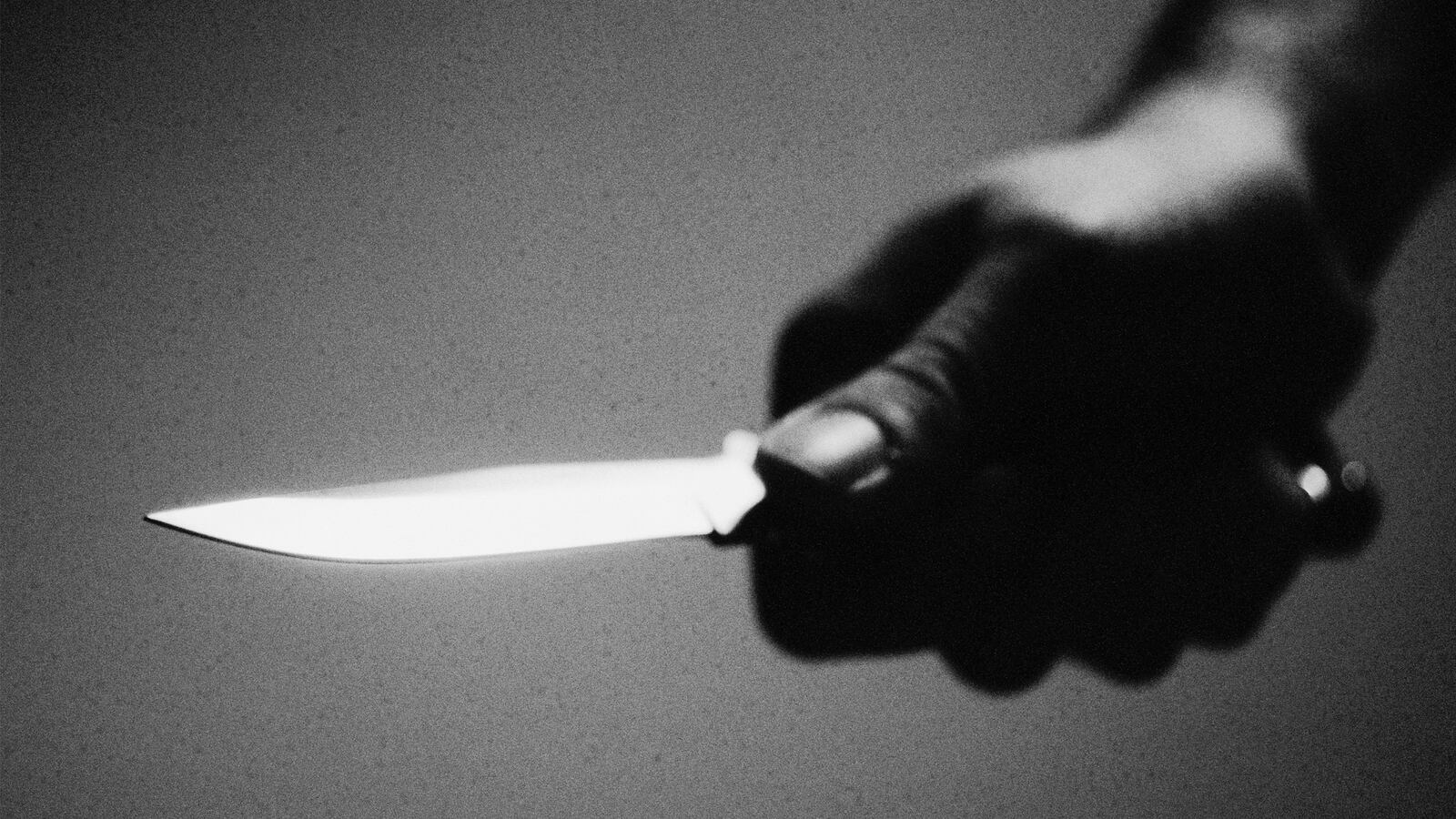AMSTERDAM—Sadegh Zarza was on his way to the train station in the Dutch city of Leeuwarden to meet the son of an old school friend from back in Iran. The young man wanted to train as a cardiologist in the Netherlands but needed some assistance settling in. Naturally, Zarza agreed to help.
And there he was, holding brightly colored flowers and speaking into his phone. “I can see you, I can see you” the young man told Zarza.
“I opened the door to let him in...” Zarza says, inhaling abruptly, as he explained to The Daily Beast what happened next. “I see him walking towards me. I am buckled up… He was holding a bunch of tulips in his hands.”
When the man reached the passenger side of the vehicle, he threw the flowers onto the backseat instead of sitting down. That’s when Zarza saw the blade.
“With a really big knife, he started to stab me. I tried to stop him with my left hand, but I was tied down by the buckle.” Time after time the knife plunged into him, his hand, his head, his stomach.
Finally, it stopped. The man thought Zarza was dead.
He wasn’t. The 64-year-old slowly pushed open the door, and crawled out of the vehicle, calling for help. The rest of the story is a blur for Zarza.
Bystanders would later tell police they saw the man calmly walk around the car and continue to slash at his victim. The blows continued until the blade of the knife snapped. Zarza had been stabbed 21 times.
That was in June. Zarza is now out of hospital. Bandages still cover his right eye and a scar runs down his cheek, to the right of a salt-and-pepper moustache.
Who would want Zarza dead?
Zarza narrowly avoided the same fate as his uncle, Abdul Rachman Ghasemmlou, who was assassinated in 1989 in Vienna. He was an Iranian-Kurdish politician and the secretary general of the Democratic Party of Iranian Kurdistan (KDPI) party. He was shot at close range shortly after a series of political meetings with representatives of the Iranian government.
Zarza and Ghasemmlou were both Iranian dissidents from a prominent Kurdish political family, who had dedicated their lives to more Kurdish autonomy, thereby challenging the Iranian regime in Tehran. Zarza was a commander in the Peshmerga and active in the KDPI for most of his life.
It is unclear who ordered the hit but Zarza, whose voice is frail but determined over the phone, said his family had discovered that the man sent to kill him had undergone training in Shiraz, southwest Iran, in what he believes was a government-orchestrated mission.
“A few years ago, the newspaper Nimrooz published a death list that had 14 names on it. My name was No. 13,” Zarza said. “That's why I went to the Dutch police to report it, and they took it very seriously. I hope the Dutch government will not choose to ignore this attack because of other, political considerations.”
So far the Dutch government has made no public statement on Iran’s involvement in the attack. A 38-year-old Iranian man was apprehended at the scene and has been held in custody ever since.
The attack came one year after the Netherlands’ minister of foreign affairs, Stef Blok, did speak out and accuse Iran of killing in Europe. He announced that Dutch and foreign intelligence services had found “clear indications” that Iran had been involved in two previous assassinations on Dutch soil.
The government of Iran denies all involvement in the killings, but the Dutch government holds Tehran responsible for the murder of Mohammad-Reza Kolahi Samadi in 2015 and Ahmad Mola Nissi in 2017. The following year, two Iranian diplomats, alleged to be members of the Iranian intelligence services, were expelled from the Netherlands, their assets were frozen, and a European Union travel ban was issued. The Dutch intelligence service, AIVD, says it is investigating the “extent of the Iranian involvement in Europe” in close cooperation with foreign colleagues.
Renewed taste for foreign assassinations
Iran has a long recent history of assassinating dissidents abroad. It’s not the only country—Russia, Israel and China have all been accused of taking out enemies of the state in foreign countries—but Iran has an extremely long list of mortal enemies, an even longer memory, and a fervent desire to keep chasing them down.
From the late ’80s to the mid-’90s, several Iranians were murdered by the regime across different European countries. But after 1996, the assassinations abroad appeared to slow down, stop even. For roughly 20 years the foreign policy of Iran didn't seem to include taking out Iranian dissidents outside its borders, until 2015 when the killing started again.
“The Iranian government's attempts to silence or eliminate exiled opponents have escalated over the past years both online and on the ground,” Maysam Behravesh, an Iranian government adviser between 2008 and 2010, told The Daily Beast.
Tracking the responsibility for Iranian killings on foreign soil is complicated by the rise of the Islamic Revolutionary Guard Corps (IRGC) within Iran’s diplomatic network around the world, where the more cautious and bureaucratic Ministry of Intelligence and Security officials would previously have run the show. And that’s before you get into the murky world of the Iran-backed Shia militia Hezbollah, which has representatives and associates everywhere.
The rise of General Qassem Soleimani, the leader of Iran’s powerful Quds Force, which is part of the IRGC, may well have increased Tehran’s willingness to dabble in overseas killings. But after his death—via a targeted U.S. missile strike in Iraq—the assassinations didn't stop.
“This is partly driven by domestic political dynamics as hardliners, and in this case the IRGC intelligence organization and its hawkish allies elsewhere in the system, are taking over and marginalizing their more moderate rivals and cooler heads in the corridors of power and decision making circles,” Behravesh wrote from Sweden.
The tensions surrounding the 2015 nuclear deal and later the antagonism of the Trump administration did not ease matters. Behravesh explains that Iran is already facing “maximum pressure” from foreign governments so it has become more assertive and aggressive in its quest for survival. “According to the hardliners' calculus, now that [Iran] is under ‘maximum pressure’ and has little left to lose politically and in reputation, why not use this opportunity to get rid of some troublesome elements and loose ends here and there?”
Add to that the growing internal unrest in Iran and the regime may feel the need to flex its muscles abroad, to deflect attention. Zarza sees the attack on his life as a reflection of that internal turmoil, with protesters in Iran's streets and economic problems, Iran lashes out, he says. “We can do whatever we want, we can touch people anywhere, anytime. It is also a message to foreign leaders: we can make your countries unsafe.”
Iran targets Iranians abroad it considers terrorists or traitors, including members of separatist movements or those representing and propagating views critical of the regime. Mohammed-Reza Kolahi Samadi was a member of the militant People's Mujahideen of Iran (MEK). He was working under an assumed name as an electrician in the Netherlands when he was targeted in 2015. The regime condemned Samadi to death for the 1981 bombing of the Islamic Republican Party, in which 73 people died.
The next murder took place in Istanbul in 2017; Saeed Karimian was an Iranian television executive. Then there was Ahmad Mola Nissi, who was murdered in The Hague. He was a member of an Arab-Iranian separatist movement.
After him, came Masoud Maulvi Vardanjani, back in Istanbul last November. He was killed a few months after he started openly criticizing Iran’s Revolutionary Guards. Reuters reported that he had posted on social media: “I will root out the corrupt mafia commanders, pray that they don’t kill me before I do this.” Turkey suspects two Iranian diplomats are involved in the murder.
Last year, attempts on the lives of Iranians were prevented in France and Denmark.
Why the Netherlands?
The Iranian community in the Netherlands has fewer than 45,000 members. Up to 27,000 of them are first-generation dissidents, most of whom arrived here after the Shah was ousted in 1979 and have been living in the bigger Dutch cities ever since.
Hussein Madjidi, head of the Kurdish-Iranian KDPI branch in the Netherlands—and a cousin of Sadegh Zarza—says it is the lack of protection given to Iranian dissidents by the Dutch security services that makes them especially vulnerable in the Netherlands. He says the Dutch authorities are not taking the problem seriously enough.
Behravesh, the former Iranian intelligence analyst, said that—according to Iran—“both the Netherlands and Scandinavian countries host some of the most subversive and separatist Iranian opposition groups, from Kurdish autonomy-seeking outfits to Arab secessionist movements.”
And yet, in these countries, the political consequences for an extraterritorial murder are slight. “Unlike big European powers such as France and Germany, where hostile intelligence operations are more difficult and entail much graver political/diplomatic consequences, it is more convenient for states like Iran and Saudi Arabia to operate in smaller and less influential countries such as the Netherlands or Denmark, Norway etc,” Behravesh said.
There could also be another, more logistical reason why Iran can get to its dissidents more easily in the Netherlands, where criminal organizations have elaborate networks in place that can do the job for them. In both previous attacks, the victims were shot in front of their homes. In the murder of Samadi the suspected killers were involved in the Amsterdam drug trade, providing deniability. It is well known that Hezbollah's ties run deep within the international drug trade, and it would be relatively easy to organize an attack with their help.
Whatever the method, the purpose of the Iranian regime is to spread its policy of fear, says Zarza’s cousin Madjidi. “Iran wants to show that its arm is long and stretches over borders. ‘We can make it unsafe on your territory too’ is what they want to say.” Iran feels justified because it believes “organizations like ours are supported by foreign governments.” Madjidi says. “It’s not the case, but this is how the Iranian government sees it.”
On Twitter, Iranian Foreign Minister Javad Zarif makes the same point. “The West must cease financing and harboring terrorists. From their safe havens in US and Europe, they promote hatred, agitate & organize murder & mayhem,” he tweeted on Aug. 1.
When an Iranian politician visited the Dutch parliament in October last year, he offhandedly explained that the Iranian regime was left with no choice but to act, even if that meant killing on Dutch territory. Local lawmaker Martijn van Helvert told the newspaper De Volkskrant that the visitor had said: “He was such a bad guy, if you don't act on that, we will.”
Erwin van Veen, a researcher at the think-tank Clingendael, said he had a similar conversation with a former Iranian diplomat who told him: “We are completely within our rights to [assassinate people], because you refuse to extradite our criminals.”
Van Veen told The Daily Beast that he had replied by saying: “We don’t because you may execute them, and that's not how we do things here.”
“Well then, that just leaves us taking them out at your end,” the diplomat said.
Zarza was an experienced military commander, but the assassination attempt has left him changed. “I can't sleep. If I hear the smallest sound downstairs, I have to check it out, out of fear for my children,” he said.
The former Peshmerga fighter finds it difficult to accept that, as a civilian, he's not allowed to carry arms. “In Kurdistan, I had my weapon at hand. If someone approached to kill me, I could defend myself. But here I am powerless, I am empty-handed.”
In Europe, you rely on law enforcement and the state to protect you. If you’re an Iranian dissident that may not be enough.





